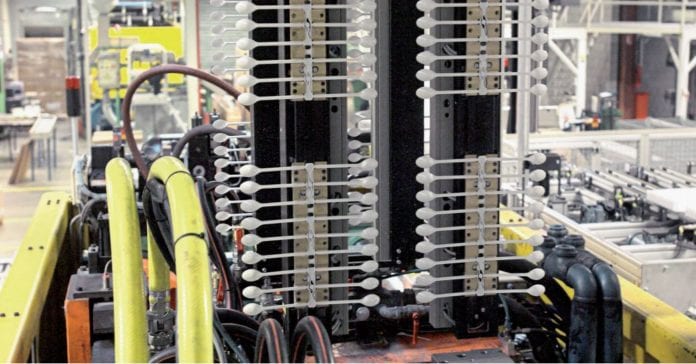A smart factory for spoons
A company out of Belgium that designs and manufactures food packaging including plastic cups, mugs, plates and cutlery, deSter created a smart factory to cut cycle times, according to a case study provided by IoT-One.

Its products are brought to the market as “tailor-made” concepts, so within a variety of brand lines, product concepts are developed for each range of application. The company said that speed and flexibility are required in all elements of its production process and used the “internet of things” to enhance these two elements and create an entirely new production line.
“Until recently, several packages for plastic spoons were delivered that were bulky and, in terms of appearance, no longer met requirements,” said Cis Woestenborghs, manufacturing engineer at deSter. “Even the previous production methods for these products were questioned. The market, however, wanted more choice, and that’s why a decision was made to develop a new line that could supply packaging units of 36, 50, 100, 250, 500, or 1,000 or more spoons. With that choice, efforts were simultaneously made to find opportunities for increasing the production speed and capacity.”
Creating a new production line using IoT
To allow customer flexibility and faster time-to-market, deSter created an entirely new semiautonomous production line. The heart of the production line is a 400-ton injection molding machine with a 144 composite mold. In one shot, no fewer than 144 spoons can be injected simultaneously.
“With the start of the new production and packaging line, we set ourselves ambitious goals: a higher production capacity, lower cycle-times and a high degree of operator friendliness for the production line,” said Woestenborghs.
One of the existing comparable production lines had a capacity of 700,000 forks per day and a cycle time of 9.5 seconds.
Meet the robots
For the new line, a doubling of the production time was envisaged and a reduction of the cycle time by one second. Thanks to the robotization, packaging volume was reduced to approximately 35%, decreasing operating expenses and increasing return on investment. The higher degree of automation allowed deSter to meet its goals, according to the company.

For unloading the products from the mold, a 6-axis IRB 6600 robot is employed. The robot is equipped with a gripper – developed in-house – that simultaneously picks up the eight cold runners and takes the 144 spoons to a trimming line. Thus, 125 frames each with 144 spoons in buffer form are stacked, which are then transported to a trimmer via an elevator belt. The individual stacks of spoons are picked up with the aid of an IRB 2400 robot, and deposited in a buffer. Depending on the desired packaging amount, the spoons are then placed in multiples of 125 in a plastic package. A third ABB robot, an IRB 140, picks up the bag of spoons and places one or several units in the box.
Then the boxes are transported via a transport line to an IRB 6600 robot for palletization. Just before the boxes are palletized, the robot moves them past an inkjet printer where the necessary product information is automatically affixed to the box.
Robots making things easier for humans
The experience with the new line is outright positive,” said Woestenborghs. “DeSter pays a lot of attention to keeping staffing and machine output under control. The departments receive all the facilities and freedom for implementing improvements. This not only concerns output increases, but also ergonomic improvements or cheaper production methods. With this system, the production activities have been further automated and staffing optimized. Relative to existing lines, production capacity has also been increased and the cycle time reduced by one second. In addition, the stacking height of the spoon frames has been raised from 50 to 125 so that packages in multiples of 125 can now be supplied.”

